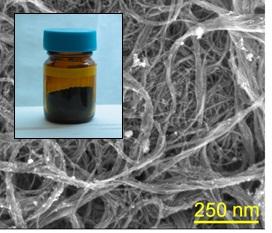Summary
Single-wall carbon nanotubes are an important class of carbon nanomaterials with significant potential for commercial applications. The National Institute of Standards and Technology (NIST) is supporting the development and commerce of these materials through metrology development and the production of documentary standards and reference materials (RMs). In December 2011, NIST released the first reference material for SWCNTs, SRM 2483, which was designed to serve an industry need for a comparable as-produced material. An separate SWCNT reference material, RM 8281 (Single-Wall Carbon Nanotubes (Dispersed, Three Length-Resolved Populations)) based on purified nanotube populations was released in 2013.
Due to changing measurement needs for these materials SRM 2483 was discontinued in 2021. RM 8281 was similarly discontinued at the end of 2022.
For details and information on potential substitute materials, go to the SRM Website
Description

Carbon nanomaterials are expected to play an important role in future technological developments of transistors, photovoltaics, transparent thin film conductors, sensors, and fuel cell electrodes among many potential applications. However, the potential of these materials has been hindered by a lack of both standard protocols (i.e. documentary standards) for determining the quality and properties of a sample material, and physical standards (RMs), which allow for common inter-comparison of measurements and a baseline from which developments can be made.
To enable and promote the potential applications for carbon nanotubes NIST has released two types of single wall carbon nanotube reference materials. These are: SRM 2483, homogenous vials of single wall carbon nanotube soot released in 2011, and RM 8281, a set of different average length nanotube populations in aqueous dispersion. Outreach to industrial users (producers and consumers) and to academic investigators identified these materials as the primary, currently feasible, reference materials necessary to enable commerce of SWCNT materials.
Major Accomplishments
SRM 2483 (single wall carbon nanotube soot) was released in December 2011. This material is certified to be homogenous within and across bottles for elemental composition, including residual metal (catalyst) content, nanotube content, and thermogravimetric measurands. The importance of this SRM, is that as the first available lot of homogenous material it will enable comparisons and repeatability tests between users of nanotube soots for the first time. Calibration of instruments, a reference for determining processing artifacts, and potential use as an environmental, health, and safety reference for nanoparticles have been expressed as desired end uses for this material.
Characterization on SRM 2483 was performed using multiple independent techniques, including thermogravimetric analysis (TGA), prompt gamma activation analysis (PGAA), induced neutron activation analysis (INAA), inductively coupled plasma - mass spectroscopy (ICP-MS), resonant Raman scattering, UV-visible-near infrared fluorescence and absorbance spectroscopies, scanning electron microscopy (SEM) and transmission electron microscopy (TEM). Values (certified, reference, or informational) are available without purchase on the SRM 2483 certificate (enter 2483 here).
Reference materials RM 8281, a set of dispersed nanotube populations with different average lengths was released in 2013; the set includes a long, medium and short fraction, as well as a 1 % (mass/volume) surfactant blank. A set contains a sealed, sterilized, ampoule (~2.6 mL) of each component. These sets were produced using centrifugation based separation of a common parent dispersion produced from SRM 2483. Applications of these materials include fundamental research, instrument calibration, and EHS applications.

